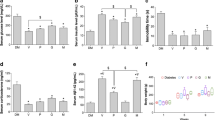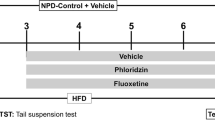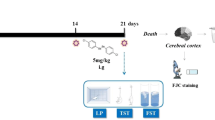Abstract
Diabetes is a chronic disease associated with depression whose pathophysiological mechanisms that associate these conditions are not fully elucidated. However, the activation of the indoleamine-2,3-dioxygenase (IDO), an enzyme that participate of the tryptophan metabolism leading to a decrease of serotonin (5-HT) levels and whose expression is associated with an immune system activation, has been proposed as a common mechanism that links depression and diabetes. To test this hypothesis, diabetic (DBT) and normoglycemic (NGL) groups had the cytokines (TNFα, IL-1β, and IL-6) and 5-HT and norepinephrine (NE) levels in the hippocampus (HIP) evaluated. Moreover, the effect of the selective serotonin reuptake inhibitor fluoxetine (FLX), IDO direct inhibitor 1-methyl-tryptophan (1-MT), anti-inflammatory and IDO indirect inhibitor minocycline (MINO), or non-selective cyclooxygenase inhibitor ibuprofen (IBU) was evaluated in DBT rats submitted to the modified forced swimming test (MFST). After the behavioral test, the HIP was obtained for IDO expression by Western blotting analysis. DBT rats exhibited a significant increase in HIP levels of TNFα, IL-1β, and IL-6 and a decrease in HIP 5-HT and NA levels. They also presented a depressive-like behavior which was reverted by all employed treatments. Interestingly, treatment with MINO, IBU, or FLX but not with 1-MT reduced the increased IDO expression in the HIP from DBT animals. Taken together, our data support our hypothesis that neuroinflammation in the HIP followed by IDO activation with a consequent decrease in the 5-HT levels can be a possible pathophysiological mechanism that links depression to diabetes.







Similar content being viewed by others
References
Wayhs CA, Manfredini V, Sitta A, Deon M, Ribas G, Vanzin C, Biancini G, Ferri M et al (2010) Protein and lipid oxidative damage in streptozotocin-induced diabetic rats submitted to forced swimming test: the insulin and clonazepam effect. Metab Brain Dis 25(3):297–304
Bellush LL, Reid SG, North D (1991) The functional significance of biochemical alterations in streptozotocin-induced diabetes. Physiol Behav 50(5):973–81
Apelqvist J, Bakker K, van Houtum WH, Schaper NC (2008) International Working Group on the Diabetic Foot (IWGDF) Editorial Board. Practical guidelines on the management and prevention of the diabetic foot: based upon the International Consensus on the Diabetic Foot (2007) Prepared by the International Working Group on the Diabetic Foot. Diabetes Metab Res Rev 24(Suppl 1):S181–7
International Diabetes Federation (2014) Diabetes: facts and figures http://www.idf.org/worlddiabetesday/toolkit/gp/facts-figures. Accessed 30 May 2015
Dei Cas A, Khan SS, Butler J, Mentz RJ, Bonow RO, Avogaro A, Tschoepe D, Doehner W et al (2015) Impact of diabetes on epidemiology, treatment, and outcomes of patients with heart failure. JACC Heart Fail 3(2):136–45
Monaghan K, McNaughten J, McGahon MK, Kelly C, Kyle D, Yong PH, McGeown JG, Curtis TM (2015) Hyperglycemia and diabetes downregulate the functional expression of TRPV4 channels in retinal microvascular endothelium. PLoS One 10(6):e0128359
Schreiber AK, Nones CF, Reis RC, Chichorro JG, Cunha JM (2015) Diabetic neuropathic pain: physiopathology and treatment. World J Diabetes 6(3):432–44
Moulton CD, Pickup JC, Ismail K (2015) The link between depression and diabetes: the search for shared mechanisms. Lancet Diabetes Endocrinol 3(6):461–471
Anderson RJ, Freedland KE, Clouse RE, Lustman PJ (2001) The prevalence of comorbid depression in adults with diabetes: a meta-analysis. Diabetes Care 24:1069–78
Golden SH, Lazo M, Carnethon M, Bertoni AG, Schreiner PJ, Diez Roux AV, Lee HB, Lyketsos C (2008) Examining a bidirectional association between depressive symptoms and diabetes. JAMA 299(23):2751–9
Rotella F, Mannucci E (2013) Depression as a risk factor for diabetes: a meta-analysis of longitudinal studies. J Clin Psychiatry 74(1):31–7
Zanoveli JM, de Morais H, da Silva Dias IC, Schreiber AK, de Souza CP, da Cunha JM (2015) Depression associated with diabetes: from pathophysiology to treatment. Curr Diabetes Rev
American Psychiatric Association (2013) Diagnostic and statistical manual of mental disorders, 5th edn. American Psychiatric Publishing, Arlington
Judd LL, Rapaport MH, Paulus MP, Brown JL (1994) Subsyndromal symptomatic depression: a new mood disorder? J Clin Psychiatry 55(Suppl):18–28
Gomez R, Barros HM (2000) Ethopharmacology of the antidepressant effect of clonazepam in diabetic rats. Pharmacol Biochem Behav 66(2):329–35
da Silva HA, Sitta A, Barschak AG, Deon M, Barden AT, Schmitt GO, Landgraff S, Gomez R et al (2007) Oxidative stress parameters in diabetic rats submitted to forced swimming test: the clonazepam effect. Brain Res 1154:137–43
Wayhs CA, Mescka CP, Vanzin CS, Ribas GS, Guerreiro G, Nin MS, Manfredini V, Barros HM et al (2013) Brain effect of insulin and clonazepam in diabetic rats under depressive-like behavior. Metab Brain Dis 28(4):563–70
de Morais H, de Souza CP, da Silva LM, Ferreira DM, Werner MF, Andreatini R, da Cunha JM, Zanoveli JM (2014) Increased oxidative stress in prefrontal cortex and hippocampus is related to depressive-like behavior in streptozotocin-diabetic rats. Behav Brain Res 258:52–64
Renn BN, Feliciano L, Segal DL (2011) The bidirectional relationship of depression and diabetes: a systematic review. Clin Psychol Rev 31(8):1239–46
Demakakos P, Zaninotto P, Nouwen A (2014) Is the association between depressive symptoms and glucose metabolism bidirectional? Evidence from the English Longitudinal Study of Ageing. Psychosom Med 76(7):555–61
Dantzer R, Kelley KW (2007) Twenty years of research on cytokine-induced sickness behavior. Brain Behav Immun 21(2):153–60
Haroon E, Raison CL, Miller AH (2012) Psychoneuroimmunology meets neuropsychopharmacology: translational implications of the impact of inflammation on behavior. Neuropsychopharmacology 37(1):137–62
Leonard BE (2014) Impact of inflammation on neurotransmitter changes in major depression: an insight into the action of antidepressants. Prog Neuropsychopharmacol Biol Psychiatry 48:261–7
Hood KK, Lawrence JM, Anderson A, Bell R, Dabelea D, Daniels S, Rodriguez B, Dolan LM (2012) Metabolic and inflammatory links to depression in youth with diabetes. Diabetes Care 35(12):2443–6
Chew BH, Shariff-Ghazali S, Fernandez A (2014) Psychological aspects of diabetes care: effecting behavioral change in patients. World J Diabetes 5(6):796–808
Downs CA, Faulkner MS (2015) Toxic stress, inflammation and symptomatology of chronic complications in diabetes. World J Diabetes 6(4):554–65
Dantzer R, O’Connor JC, Freund GG, Johnson RW, Kelley KW (2008) From inflammation to sickness and depression: when the immune system subjugates the brain. Nat Rev Neurosci 9(1):46–56
Vincent AM, Callaghan BC, Smith AL, Feldman EL (2011) Diabetic neuropathy: cellular mechanisms as therapeutic targets. Nat Rev Neurol 7(10):573–83
Dobos N, de Vries EF, Kema IP, Patas K, Prins M, Nijholt IM, Dierckx RA, Korf J et al (2012) The role of indoleamine 2,3-dioxygenase in a mouse model of neuroinflammation-induced depression. J Alzheimers Dis 28(4):905–15
Maes M, Rief W (2012) Diagnostic classifications in depression and somatization should include biomarkers, such as disorders in the tryptophan catabolite (TRYCAT) pathway. Psychiatry Res 196(2–3):243–9
Maes M (2011) Depression is an inflammatory disease, but cell-mediated immune activation is the key component of depression. Prog Neuropsychopharmacol Biol Psychiatry 35(3):664–75
Maes M, Leonard BE, Myint AM, Kubera M, Verkerk R (2011) The new ‘5-HT’ hypothesis of depression: cell-mediated immune activation induces indoleamine 2,3-dioxygenase, which leads to lower plasma tryptophan and an increased synthesis of detrimental tryptophan catabolites (TRYCATs), both of which contribute to the onset of depression. Prog Neuropsychopharmacol Biol Psychiatry 35(3):702–21
Molina-Hernández M, Tellez-Alcántara NP, Pérez-García J, Olivera-Lopez JI, Jaramillo-Jaimes MT (2008) Antidepressant-like actions of minocycline combined with several glutamate antagonists. Prog Neuropsychopharmacol Biol Psychiatry 32(2):380–6
Guan XT, Shao F, Xie X, Chen L, Wang W (2014) Effects of aspirin on immobile behavior and endocrine and immune changes in the forced swimming test: comparison to fluoxetine and imipramine. Pharmacol Biochem Behav 124:361–6
Zaminelli T, Gradowski RW, Bassani TB, Barbiero JK, Santiago RM, Maria-Ferreira D, Baggio CH, Vital MA (2014) Antidepressant and antioxidative effect of Ibuprofen in the rotenone model of Parkinson’s disease. Neurotox Res 26(4):351–62
Porsolt RD, Le Pichon M, Jalfre M (1977) Depression: a new animal model sensitive to antidepressant treatments. Nature 266(5604):730–2
Detke MJ, Rickels M, Lucki I (1995) Active behaviors in the rat forced swimming test differentially produced by serotonergic and noradrenergic antidepressants. Psychopharmacology (Berl) 121(1):66–72
Cryan JF, Valentino RJ, Lucki I (2005) Assessing substrates underlying the behavioral effects of antidepressants using the modified rat forced swimming test. Neurosci Biobehav Rev 29(4–5):547–69
Carvalho MC, Albrechet-Souza L, Masson S, Brandão ML (2005) Changes in the biogenic amine content of the prefrontal cortex, amygdala, dorsal hippocampus, and nucleus accumbens of rats submitted to single and repeated sessions of the elevated plus-maze test. Braz J Med Biol Res 38(12):1857–66
Bradford MM (1976) A rapid and sensitive method for the quantitation of microgram quantities of protein utilizing the principle of protein-dye binding. Anal Biochem 72:248–54
Mao XY, Cao DF, Li X, Yin JY, Wang ZB, Zhang Y, Mao CX, Zhou HH et al (2014) Huperzine A ameliorates cognitive deficits in streptozotocin-induced diabetic rats. Int J Mol Sci 15(5):7667–83
Dey A, Hao S, Erion JR, Wosiski-Kuhn M, Stranahan AM (2014) Glucocorticoid sensitization of microglia in a genetic mouse model of obesity and diabetes.J. Neuroimmunol 269(1–2):20–7
Yang RH, Lin J, Hou XH, Cao R, Yu F, Liu HQ, Ji AL, Xu XN et al (2014) Effect of docosahexaenoic acid on hippocampal neurons in high-glucose condition: involvement of PI3K/AKT/nuclear factor-κB-mediated inflammatory pathways. Neuroscience 274:218–28
Hwang IK, Choi JH, Nam SM, Park OK, Yoo DY, Kim W, Yi SS, Won MH et al (2014) Activation of microglia and induction of pro-inflammatory cytokines in the hippocampus of type 2 diabetic rats. Neurol Res 36(9):824–32
Maedler K, Sergeev P, Ris F, Oberholzer J, Joller-Jemelka HI, Spinas GA, Kaiser N, Halban PA et al (2002) Glucose-induced β cell production of IL-1β contributes to glucotoxicity in human pancreatic islets. J Clin Invest 110(6):851–60
Maedler K, Fontana A, Ris F, Sergeev P, Toso C, Oberholzer J, Lehmann R, Bachmann F et al (2002) FLIP switches Fas-mediated glucose signaling in human pancreatic β cells from apoptosis to cell replication. Proc Natl Acad Sci U S A 99(12):8236–41
Emanuelli B, Glondu M, Filloux C, Peraldi P, Van Obberghen E (2004) The potential role of SOCS-3 in the interleukin-1beta-induced desensitization of insulin signaling in pancreatic beta-cells. Diabetes 53(Suppl 3):S97–S103
Vassiliou EK, Gonzalez A, Garcia C, Tadros JH, Chakraborty G, Toney JH (2009) Oleic acid and peanut oil high in oleic acid reverse the inhibitory effect of insulin production of the inflammatory cytokine TNF-alpha both in vitro and in vivo systems. Lipids Health Dis 8:25
Ando Y, Shinozawa Y, Iijima Y, Yu BC, Sone M, Ooi Y, Watanaka Y, Chida K et al (2015) Tumor necrosis factor (TNF)-α-induced repression of GKAP42 protein levels through cGMP-dependent kinase (cGK)-Iα causes insulin resistance in 3T3-L1 adipocytes. J Biol Chem 290(9):5881–92
Grishman EK, White PC, Savani RC (2012) Toll-like receptors, the NLRP3 inflammasome, and interleukin-1β in the development and progression of type 1 diabetes. Pediatr Res 71(6):626–32
Cryan JF, Markou A, Lucki I (2002) Assessing antidepressant activity in rodents: recent developments and future needs. Trends Pharmacol Sci 23(5):238–45
Slattery DA, Cryan JF (2012) Using the rat forced swim test to assess antidepressant-like activity in rodents. Nat Protoc 7(6):1009–14
Ramakrishnan R, Sheeladevi R, Suthanthirarajan N, Namasivayam A (2005) An acute hyperglycemia or acidosis-induced changes of indolamines level correlates with PKC-α expression in rat brain. Brain Res Bull 67(1–2):46–52
Ezzeldin E, Souror WA, El-Nahhas T, Soudi AN, Shahat AA (2014) Biochemical and neurotransmitters changes associated with tramadol in streptozotocin-induced diabetes in rats. Biomed Res Int 2014:238780
Li JX, France CP (2008) Food restriction and streptozotocin treatment decrease 5-HT1A and 5-HT2A receptor-mediated behavioral effects in rats. Behav Pharmacol 19(4):292–7
Umeda Y, Amano M, Suemaru K, Yamaguchi T, Kitamura Y, Gomita Y, Kawasaki H, Araki H (2007) The Influence of hyperactivity of the hypothalamic-pituitary-adrenal axis and hyperglycemia on the 5-HT2A receptor-mediated wet-dog shake responses in rats. Acta Med Okayama 61(6):311–7
de Montigny C (1977) Neurophysiology and current trends in research on depression. Remarks on the monoaminergic hypothesis of depression. Union Med Can 106(6):805–10
Delgado PL (2000) Depression: the case for a monoamine deficiency. J Clin Psychiatry 61(Suppl 6):7–11
Prabhakar V, Gupta D, Kanade P, Radhakrishnan M (2015) Diabetes-associated depression: the serotonergic system as a novel multifunctional target. Indian J Pharmacol 47(1):4–10
Corona AW, Norden DM, Skendelas JP, Huang Y, O’Connor JC, Lawson M, Dantzer R, Kelley KW et al (2013) Indoleamine 2,3-dioxygenase inhibition attenuates lipopolysaccharide induced persistent microglial activation and depressive-like complications in fractalkine receptor (CX(3)CR1)-deficient mice. Brain Behav Immun 31:134–42
Salazar A, Gonzalez-Rivera BL, Redus L, Parrott JM, O’Connor JC (2012) Indoleamine 2,3-dioxygenase mediates anhedonia and anxiety-like behaviors caused by peripheral lipopolysaccharide immune challenge. Horm Behav 62(3):202–9
Lawson MA, Parrott JM, McCusker RH, Dantzer R, Kelley KW, O’Connor JC (2013) Intracerebroventricular administration of lipopolysaccharide induces indoleamine-2,3-dioxygenase-dependent depression-like behaviors. J Neuroinflammation 18(10):87
Xie W, Cai L, Yu Y, Gao L, Xiao L, He Q, Ren Z, Liu Y (2014) Activation of brain indoleamine 2,3-dioxygenase contributes to epilepsy-associated depressive-like behavior in rats with chronic temporal lobe epilepsy. J Neuroinflammation 11:41
Kim SS, Kong PJ, Kim BS, Sheen DH, Nam SY, Chun W (2004) Inhibitory action of minocycline on lipopolysaccharide induced release of nitric oxide and prostaglandin E2 in BV2 microglial cells. Arch Pharm Res 27:314–318
Morimoto N, Shimazawa M, Yamashima T, Nagai H, Hara H (2005) Minocycline inhibits oxidative stress and decreases in vitro and in vivo ischemic neuronal damage. Brain Res 1044:8–15
Ahuja M, Bishnoi M, Chopra K (2008) Protective effect of minocycline, a semi-synthetic second-generation tetracycline against 3-nitropropionic acid (3-NP)-induced neurotoxicity. Toxicology 244:111–122
Homsi S, Federico F, Croci N, Palmier B, Plotkine M, Marchand-Leroux C, Jafarian-Tehrani M (2009) Minocycline effects on cerebral edema: relations with inflammatory and oxidative stress markers following traumatic brain injury in mice. Brain Res 1291:122–32
Orio L, Llopis N, Torres E, Izco M, O’Shea E, Colado MI (2010) A study on the mechanisms by which minocycline protects against MDMA (‘ecstasy’)-induced neurotoxicity of 5-HT cortical neurons. Neurotox Res 18:187–199
Dean OM, Data-Franco J, Giorlando F, Berk M (2012) Minocycline: therapeutic potential in psychiatry. CNS Drugs 26:391–401
Henry CJ, Huang Y, Wynne A, Hanke M, Himler J, Bailey MT, Sheridan JF, Godbout JP (2008) Minocycline attenuates lipopolysaccharide (LPS)-induced neuroinflammation, sickness behavior and anhedonia. J Neuroinflammation 5:15
Dean OM, Maes M, Ashton M, Berk L, Kanchanatawan B, Sughondhabirom A, Tangwongchai S, Ng C et al (2014) Protocol and rationale—the efficacy of minocycline as an adjunctive treatment for major depressive disorder: a double blind, randomised, placebo controlled trial. Clin Psychopharmacol Neurosci 12(3):180–188
Liu YW, Zhu X, Zhang L, Lu Q, Zhang F, Guo H, Yin XX (2014) Cerebroprotective effects of ibuprofen on diabetic encephalopathy in rats. Pharmacol Biochem Behav 117:128–36
Liu D, Wang Z, Liu S, Wang F, Zhao S, Hao A (2011) Anti-inflammatory effects of fluoxetine in lipopolysaccharide(LPS)-stimulated microglial cells. Neuropharmacology 61(4):592–9
Obuchowicz E, Bielecka AM, Paul-Samojedny M, Pudełko A, Kowalski J (2014) Imipramine and fluoxetine inhibit LPS-induced activation and affect morphology of microglial cells in the rat glial culture. Pharmacol Rep 66(1):34–43
Oxenkrug G, Ratner R, Summergrad P (2013) Kynurenines and vitamin B6: link between diabetes and depression. J Bioinform Diabetes. 1(1).
Belenky P, Bogan KL, Brenner C (2007) NAD+ metabolism in health and disease. Trends Biochem Sci 32(1):12–9
Rogers KS, Higgins ES, Kline ES (1986) Experimental diabetes causes mitochondrial loss and cytoplasmic enrichment of pyridoxal phosphate and aspartate aminotransferase activity. Biochem Med Metab Biol 36(1):91–7
Tagliari B, Noschang CG, Ferreira AG, Ferrari OA, Feksa LR, Wannmacher CM, Dalmaz C, Wyse AT (2010) Chronic variable stress impairs energy metabolism in prefrontal cortex and hippocampus of rats: prevention by chronic antioxidant treatment. Metab Brain Dis 25(2):169–76
Regenold WT, Pratt M, Nekkalapu S, Shapiro PS, Kristian T, Fiskum G (2012) Mitochondrial detachment of hexokinase 1 in mood and psychotic disorders: implications for brain energy metabolism and neurotrophic signaling. J Psychiatr Res 46(1):95–104
Oxenkrug G (2013) Insulin resistance and dysregulation of tryptophan-kynurenine and kynurenine-nicotinamide adenine dinucleotide metabolic pathways. Mol Neurobiol 48(2):294–301
Gold PW (2015) The organization of the stress system and its dysregulation in depressive illness. Mol Psychiatry 20(1):32–47
Acknowledgments
This study was supported by grants from CNPq (Casadinho/PROCAD Grant No. 479526/2012-5). The authors thank Prof. Dr. Maria ABF Vital for kind donation of the ibuprofen and minocycline and also the technical assistance of Giuliana Bertozi during the cytokine measurement by ELISA method.
Author information
Authors and Affiliations
Corresponding author
Ethics declarations
Conflict of Interest
The authors declare they have no conflicts of interest to disclose.
Electronic Supplementary Material
Below is the link to the electronic supplementary material.
ESM 1
(DOC 48 kb)
Rights and permissions
About this article
Cite this article
da Silva Dias, I.C., Carabelli, B., Ishii, D.K. et al. Indoleamine-2,3-Dioxygenase/Kynurenine Pathway as a Potential Pharmacological Target to Treat Depression Associated with Diabetes. Mol Neurobiol 53, 6997–7009 (2016). https://doi.org/10.1007/s12035-015-9617-0
Received:
Accepted:
Published:
Issue Date:
DOI: https://doi.org/10.1007/s12035-015-9617-0




